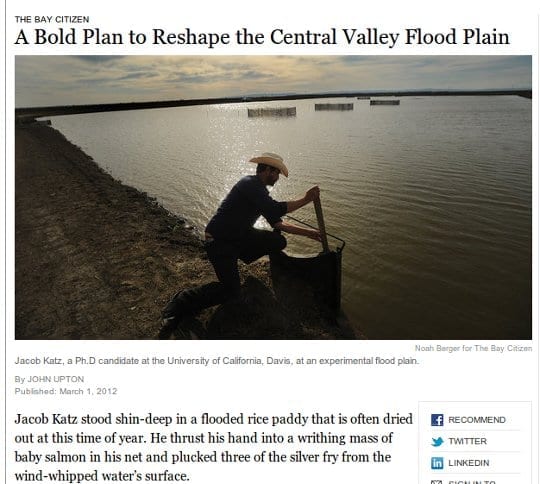CalTrout Helping To Reconnect Central Valley Floodplains To Rivers
California’s Central Valley floodplains have been largely disconnected from the Sacramento River by levees, which have dramatically reduced the amount of “spillover” space available to the river.
Unfortunately, these little-understood floodplains served as ideal nurseries for juvenile salmon, who grow more quickly and face fewer predators than they do in the faster-moving, less-nutrient-rich, predator-friendly main river channel.
Though we’re not mentioned in this New York Times story, CalTrout is funding part of this UC Davis study on the effects of reconnect rivers with floodplains:
Jacob Katz stood shin-deep in a flooded rice paddy that is often dried out at this time of year. He thrust his hand into a writhing mass of baby salmon in his net and plucked three of the silver fry from the wind-whipped water’s surface.
The flood plain was stocked with baby Chinook salmon.
In late January, five acres of this farmland in Yolo County was flooded and stocked with thousands of weeks-old Chinook salmon. It was the beginning of a three-year experiment that conservationists and government officials hope will provide scientific data to help guide a sweeping transformation of riverfront lands throughout the Central Valley, California’s prolific farming region.
“They were about two-thirds this size when we put them in,” said Mr. Katz, a doctoral candidate at the University of California, Davis, as the plump fry flapped off his palm and into the water. “They’re growing very, very rapidly. They’re looking great. It’s exactly what we want to see.”
It seems clear that floodplains are one of the missing pieces of the anadromous fish puzzle, and equally clearly, it’s not only fish that stand to suffer.
Channelization of large rivers takes away the safety valve of floodplains, increasing the potential for highly destructive levee failures and flooding (both for people and property).
Restoring some of this balance is tricky, and CalTrout supports such efforts when they’re based on the best available science.
To read the entire New York Times article, click here.






1 Comment
I aiways felt if those